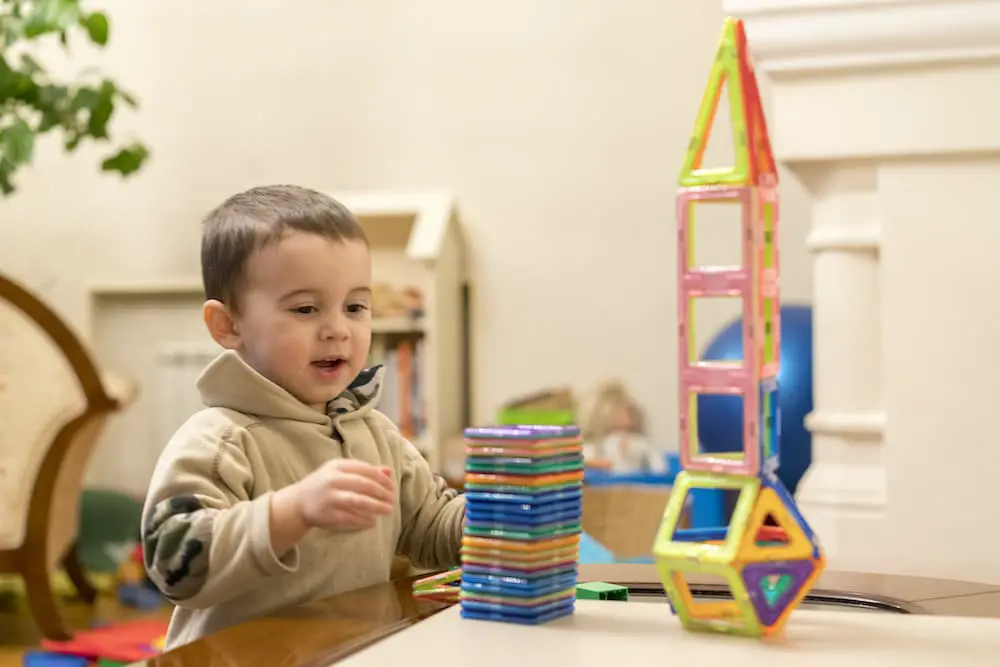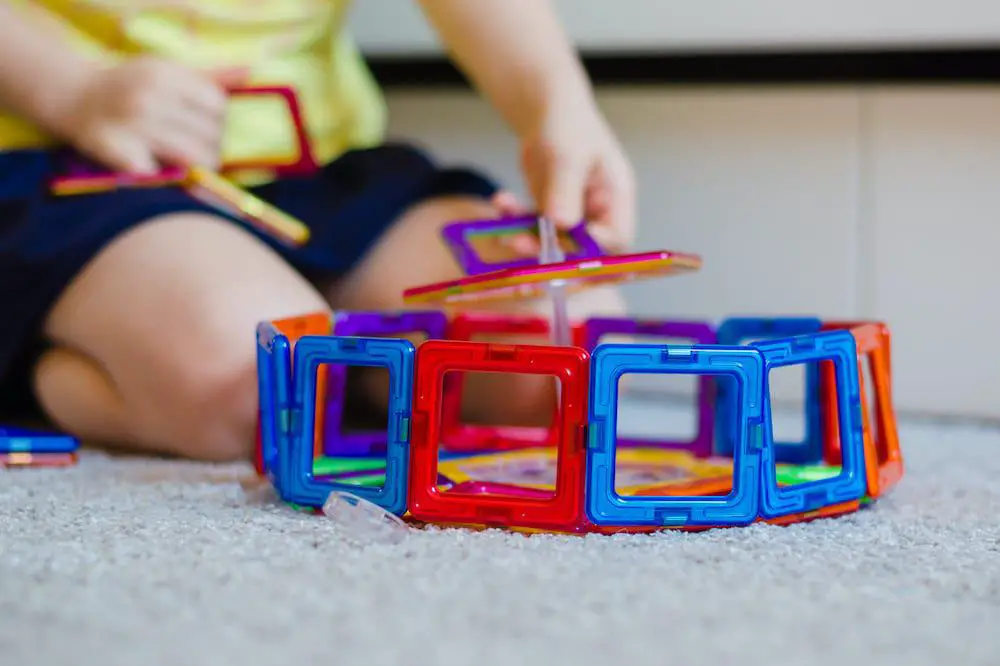Many parents want to get toys for their children, and fortunately, there are a lot of interactive and fun options nowadays.
Apart from being enjoyable, though, it’s important to make sure your young kids don’t get harmed from playing with the toys you buy for them.
In fact, as lightweight and sharp-edge-free as they are, not all plastic toys are not as safe as they seem to be.
How about magnetic ones? Are magnetic toys safe for toddlers?
Let’s answer all those by learning more about magnetic toys and why they may be unsuitable for young children.
Are Magnetic Toys Safe for Toddlers?
In the early 2000s, most shops through the USA sold toys that have unique magnets.
These magnets utilize rare earth metals, which are more powerful than the traditional refrigerator magnet.
Usually, the toys have multiple small magnets so that kids can make flexible and creative shapes.
It also makes it easy for them to take the toy apart to build things and connect them in various ways.
Some of them were even marketed to be stress-relieving or novelty toys. They could sit on the desk and provide a mental break for long homework sessions.
What the Experts Say
However, the Consumer Product Safety Commission in the USA now warns parents to be cautious of such toys.
That is because these small, yet high-powered magnets could be life-threatening to young kids, especially if they swallow them.
For example, if your child ingests multiple magnets, they could attract each other, which means they could pinch the tissues when they stack together.
Many magnets in someone’s digestive system could cause severe intestinal, stomach, or digestive tract injuries.
These may include bowel obstruction and twisting, perforation, necrosis, and sepsis.
Such internal injuries could cause death or lifelong health problems and might require surgery.
According to the CPSC, from 2009 to 2013, high-powered magnet sets killed one toddler and led to 2,900 injuries that required a trip to the emergency room.
Even tweens and teenagers are at risk because some of them have tried to create tongue, lip, and nose piercings with the magnets.
Symptoms of Magnet Ingestion
Toddlers can’t talk well or at all, so they can’t tell you that they have swallowed it. Even older children may not admit it at first, especially if they believe they will get in trouble.
Hence, for you to take immediate action when your kid swallowed magnets accidentally, you must know what the symptoms are for magnet ingestion.
Usually, if a child has swallowed magnets, they will experience abdominal and stomach pain.
It could get quite intense, and they are sure to cry uncontrollably. They may also be vomiting and could have a fever.
However, these symptoms are common for young children, so it might be hard to immediately determine the cause.
Many parents delay treatment because they believe it is a common virus causing the problem, putting their children at high risk of long-term injury or death.
As such, you should take your child to the doctor or emergency room if he or she is experiencing any of these symptoms.
Let the healthcare professional know that you have magnet sets in the home.
Tips for Protecting Your Children From Magnet Dangers
Of course, there are a few things you can do to keep magnets away from young children.
Most parents just do not buy them, which is 100 percent effective, but you may have magnets on the refrigerator or elsewhere at home that you have not considered.
So, here are what you can do:
- Make sure that you always keep any product with small or loose parts away from young children. They are known to put anything in their mouths to investigate and play.
- If the toy contains a magnet, it is best not to let your toddler play with it, or you should watch your child every moment they’re playing with toys that have loose or small parts.
- It’s also important to keep track of the magnets at all times. Ideally, purchase magnet sets that have fewer than 100 pieces. You may find it easier to recognize that a few magnets are missing when there aren’t so many.
- When they are not being used or played with, make sure the magnets are out of reach of toddlers.
- If you have older children who like magnets, talk with them. Let them know how dangerous these toys are to their little brother or sister.
- Don’t let your older children use these magnets as faux piercings and swallow or inhale them.
- Make sure your older children keep them picked up and put away when they aren’t using them. You may also take the magnets and store them in your bedroom for safekeeping.

What Is CPSC Doing or Have Done?
Many parents and consumer advocacy groups want high-powered magnet toys to be banned permanently and indefinitely.
CPSC is a federal agency that ensures consumer products being sold, especially children’s toys, are safe.
Here are the actions they did regarding magnet toys:
1. Recalled Toys
Data showed that hundreds of children were hospitalized with magnet-related injuries, so the US CPSC deemed such magnet toys as a safety risk.
In 2014, they recalled from the market multiple toys, such as the Magtastik and Jr. Version from Magnetix and the Toulouse-LapTrec Sketch Boards from Rainbow Force Plastic Products, and parents were happy with this action.
Immediately after that, magnet ingestions by toddlers and older children decreased by about 80 percent.
Unfortunately, the 10th Circuit Court of Appeals decided to vacate that order in 2016. As such, the toys were back on the shelves.
Though manufacturers started taking precautions, it’s still not enough, according to the CPSC and other advocacy groups.
3. Regulated Magnet Toys
Since magnets can’t be eliminated completed, especially for older children’s toys and items, back in 2014, the CPSC created new standards for magnet sets to protect.
These regulations specified that each magnet had to meet attraction and size standards that have been determined as safe by this agency.
Some of the previous toy sets in the marketplace feature magnetic forces that were 37 times more than this new performance standard allows.
4. Required Warning Labels
Manufacturers also have to put a warning on the packaging when they use rare-earth magnets in their toys.
Still, most people don’t agree that this is sufficient since some don’t think about the significant risks of ingested magnets. They only do so once their children have been negatively affected.
Remember, children are curious. Their goal is to explore the world around them with as many senses as they can.
Taste and touch are part of that, and this isn’t going to change.
Though the labels do indicate risk, it is still up to the parents to understand the severity of the situation.
With that said, most parents just don’t buy the magnets and keep them out of the house.
Still, there is no way to prevent other parents from buying them.
If your child goes to a friend’s house and brings home a magnet, you may not know. Then, your young toddler could swallow them accidentally.
5. Encourage Reporting Magnet Ingestion Incidences and Injuries
The CPSC has an online database where you can report any incidents relating to consumer products.
You can report any minor and major injuries from magnetic products such as cuts.
You can also claim that a particular product is dangerous, and the CPSC can look into it and take appropriate action. Likewise, you must report magnet ingestion and related injuries.
Information Privacy
If you report an injury or issue, you can provide your information or that of the child, but this is not required.
Though the CPSC publicly discloses any investigation or accident reports, personal information is not included.
Still, the CPSC could contact you directly for more details. Regardless, your contact information isn’t shared with anyone else.
The Usefulness of the Reports
Many parents want to have these dangerous magnet products removed from the market.
To do that, the CPSC depends on injury reports associated with such products.
Therefore, you are always encouraged to report such magnet-related injuries to the CPSC.
Magnetic Toys for Toddlers: The Takeaway
Since the answer to “Are magnetic toys safe for toddlers?” is a yes, in most cases, you must not let your kid play with them.
They can be very damaging to the internal organs and cause a choking hazard.
Although there are times where they can play with them, especially when an adult is watching, it’s always possible for you to look away for a second, and your toddler could swallow it.
Therefore, the safest method to ensure that your child cannot ingest it is not to purchase magnetic toys.
Even as your child grows older, magnetic toys might not be safe. Tweens and teenagers can swallow them accidentally while trying to make nose or mouth rings.
Thus, it is also best to discuss to your older children the dangers of magnets to make sure they stay safe and be mindful of their younger siblings.
Though the CPSC has changed the rules governing their production, these toys can still be dangerous.
If your child has swallowed a magnet or you think they have, seek medical attention, and report the incident to CPSC.

